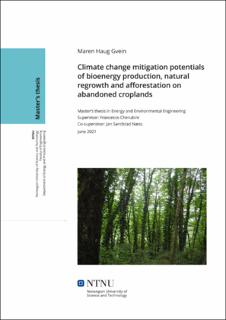| dc.contributor.advisor | Cherubini, Francesco | |
| dc.contributor.advisor | Næss, Jan Sandstad | |
| dc.contributor.author | Gvein, Maren Haug | |
| dc.date.accessioned | 2021-10-03T16:19:41Z | |
| dc.date.available | 2021-10-03T16:19:41Z | |
| dc.date.issued | 2021 | |
| dc.identifier | no.ntnu:inspera:80324182:64327807 | |
| dc.identifier.uri | https://hdl.handle.net/11250/2787158 | |
| dc.description.abstract | Karbonopptak og -lagring som følge av landbruksendringer har fått økende oppmerksomhet som viktige bidrag i fremtidig klimaarbeid. Ettersom økende press på landarealer og konkurranse mellom ulike sektorer fortsatt er betydelige utfordringer, undersøker denne studien potensialene knyttet til å utnytte globale forlatte jordbruksområder til klimatiltak i form av endringer i landområder. Studien fokuserer på substituering av fossilt drivstoff og karbonfangst- og lagring (CCS) fra produksjon av bioenergi (scenarier kalt BE og BECCS), naturlig gjenvekst (NR) og påskogning (AF). Optimal distribusjon av disse strategiene er evaluert med hensyn til høyeste potensial for karbonopptak og reduksjon i klimagassutslipp, i tillegg til sårbare områder med høyt biomangfold (eng: biodiversity hotspots). Et totalt jordbruksareal på 97.6 Mha ble identifisert som forlatt i perioden 1992-2018, hvor omtrent 37.6 Mha befinner seg innenfor sårbare områder og 60 Mha utenfor. Optimal distribusjon tildeler 77.91 % av områdene til BECCS, 25.48 % til AF og 3.50 % til NR. Denne distribusjonen bidrar til totalt 2.56 GtCO2eq.yr-1 fra karbonopptak og reduksjoner i klimagassutslipp. Forlatte jordbruksområder er identifisert ved å bruke satelittdata distribuert av European Space Agency Climate Change Initiative (ESA CCI), som videre er integrert med data for biomasse fra Global Agro-ecological Zones (GAEZ), data for påskogning fra Global Forest Model (G4M) og data for naturlig gjenvekst fra Cook-Patton et al. 2020. Alle beregninger er gjort for en periode på 30 år. | |
| dc.description.abstract | Carbon sequestration and capture and storage from land use activities are considered promising and essential contributions in future climate change mitigation. As pressure on land areas and competition between land use sectors still are significant challenges, this study investigates the potentials of exploiting global abandoned croplands for land based climate change initiatives. Assessed here is the comparison of fossil fuel substitution and carbon capture and storage (CCS) from bioenergy production (scenarios called BE and BECCS), natural regrowth (NR) and afforestation (AF). The optimal distribution of these land use strategies is evaluated emphasizing the highest mitigation potential, in addition to scarce land areas in biodiversity hotspots. A total area of 97.6 Mha of croplands were identified as abandoned between 1992 and 2018, where approximately 37.6 Mha are located inside biodiversity hotspots and 60 Mha outside. The optimal distribution of the land use strategies dedicated 77.91 % of the abandoned croplands to BECCS, 25.48 % to AF and 3.50 % to NR. This distribution contributes with a mitigation potential of 2.56 GtCO2eq.yr-1. Abandoned croplands are identified using high-resolution satellite land cover data from ESA CCI and furthermore integrated with Global Agro-ecological Zones (GAEZ) drymass yield, the Global Forest Model (G4M) and natural regrowth data from Cook-Patton et al. 2020. All calculations are conducted for a period of 30 years in 5 arc minutes spatial resolution. | |
| dc.language | eng | |
| dc.publisher | NTNU | |
| dc.title | Climate change mitigation potentials of bioenergy production, natural regrowth and afforestation on abandoned croplands | |
| dc.type | Master thesis | |
